Killeen House (Kilcolman)
Houses within 15km of this house
Displaying 64 houses.
Houses within 15km of Killeen House (Kilcolman)
Displaying 64 houses.
| House name | Description | |
|---|---|---|
| Killorglin Glebe | Rev. Robert Denny was leasing Killorglin Glebe to Rev. William de Moelyns at the time of Griffith’s Valuation, when it was valued at £16. The site now appears to be occupied by agricultural buildings. | |
| The Reeks or Baunclune | The McGillycuddy was in possession of the property at Whitefield at the time of Griffith’s Valuation when it was valued at £24 10s. Lewis and Leet also refer to Whitefield as a seat of The McGillycuddy in 1837 and 1814 respectively. Leet, however, also notes McGillycuddy Reeks as the address of McGillycuddy esq. In 1906 it was McGillycuddy property and valued at £24. Bary states that the house was originally known as The Reeks after the family title but that it was changed to Whitefield in the early 19th century by Richard McGillycuddy. However, on both the 1st and 25-edition Ordnance Survey maps it is labelled Baunclune. In more recent times it is known as The Reeks. This is how it is referred to by the Irish Tourist Association surveyor in the early 1940s who states that it was the the home of "Ross Kinloch, the MacGillycuddy of the Reeks and a member of Seanad Eireann". The house is still extant and occupied. |
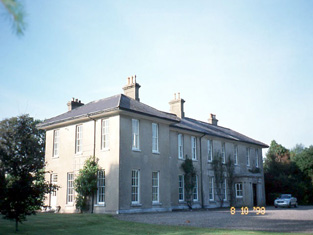
|
| Grenagh House | Denis Lawlor was leasing Grenagh House from Henry Herbert’s estate at the time of Griffith’s Valuation when it was valued at £23 15s. Lewis mentions Grena as the seat of John O’Connell in 1837. The Ordnance Survey Name Books indicate that it was built by Mrs. Delaney in 1792. Bary states that O’Connell was obliged to leave the house due to debts. It then came into the possession of Denis Shine Lawlor and later again, Daniel James. It was afterwards the property of the O'Connor family but has been ruinous since the mid twentieth century. | |
| Caherdean House | Charles Daly was leasing Caherdean House from Henry Herbert at the time of Griffith’s Valuation, when it was valued at £11 10s. Bary suggests that the Lawlors may have had connections with Caherdean House around 1800 but later in the 19th century the Herberts were the landlords. The house is still extant and part of a large farm. . |

|
| Ballymalis | Christopher Gallway was leasing a property from John Sealy, which included a mill, at Ballymalis at the time of Griffith’s valuation. It was then valued at £34. It is labelled "paper mill" on the 1st edition Ordnance Survey map and as "woollen mill" on the 25-inch edition of the 1890s. An extensive range of buildings still exists at the site. Elsewhere in this townland is Ballymalis Castle, a tower house in existence since the sixteenth century and latterly, associated with the Eager family. | |
| Knocknamucklagh House | Charles Daly was leasing this property from the Kenmare estate at the time of Griffith’s Valuation, when it was valued at £5 10s. Bary indicates that this is a very old property, possibly built by the Fitzgeralds in the early 18th century when they were Kenmare’s tenants here. By the middle of the 19th century the Daly family were occupying the property which is still extant. | |
| Knockaneacoolteen House | William Curtayne was leasing this house from Lord Kenmare’s estate at the time of Griffith’s Valuation, when it was valued at £4 10s and stood on over 300 acres. Bary indicates that the house, possibly built in the 18th century, is still extant. | |
| Churchtown | At the time of Griffith’s Valuation, Sir A. Blennerhassett was leasing Churchtown House to Robert Stokes. In 1837 Lewis refers to it as the seat of Sir A. Blennerhassett. Leet mentions it as the residence of R.A. Blennerhassett in 1814. The house was valued at £31. Churchtown House is still extant. Much of the demesne is now part of Beaufort Golf Course. |
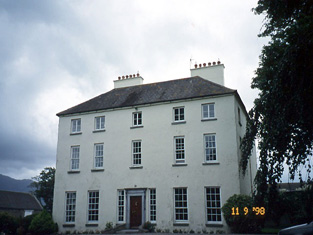
|
| Bunow Mill | John Palmer was leasing a property, including a flour mill, valued at £51 from the estate of Olivia Donovan at the time of Griffith's Valuation. | |
| Garrahies | At the time of Griffith’s Valuation, this property, valued at £11, was being leased by Edward Day to Francis Fitzgerald. In 1837 Lewis records it as the seat of F. Fitzgerald. Bary states that it remained in the Fitzgerald family until the 1930s. It was still extant in the late twentieth century. | |
| Knockglass | Edward F. Day was leasing this property to Ursula Rae at the time of Griffith’s Valuation, when it was valued at £11. Lewis refers to it as the home of Mrs. Rae in 1837. Bary states that it later passed by marriage to the McIntosh family but that the house is now ruinous. | |
| Beaufort | Reverend Edward Day was in possession of the house at Beaufort at the time of Griffith’s Valuation when it was valued at £37. Lewis refers to it as the seat of Frederick W. Mullins in 1837. In 1814 Leet also refers to it as the residence of Reverend F. Mullins. In 1786 Wilson refers to Beaufort as the seat of Hon. Dean Crosbie. Various sources, including Bary, indicate that it was built on the site of a tower house known as Short Castle. . It was sold by the Mullins estate in the mid nineteenth century to the Day family who sold it again in the 1880s. Referred to by Slater in 1894 as the seat of Lt-Col. E. Nash Leahy. It is still extant and occupied. |

|
| Cullenagh House | At the time of Griffith’s Valuation, Cullenagh House was occupied by Kean Mahony when it was valued at £22. Lewis records it as the seat of Kean Mahony in 1837 as does Leet in 1814. In 1906 it was the property of Thomas McDonagh Mahony and valued at £18. Bary states that this house was probably built by the Mahonys towards the end of the 18th century. It was still extant but uninhabited towards the end of the twentieth century. | |
| Cullenagh Lower | Myles Mahony was occupying a house at Cullenagh Lwr at the time of Griffith’s Valuation. It was valued at £6 and part of a holding of 176 acres. The house is not shown on thre 25-inch Ordnance Survey map of the 1890s. | |
| Dunloe Castle | At the time of Griffith's Valuation, Daniel Mahony was leasing Dunloe Castle from Thomas H. Broderick when it was valued at £15. Lewis describes it as formerly the seat of the O’Sullivan family but in 1837 the residence of D. Mahony. Leet refers to it as the residence of Daniel Mahony in 1814. Wilson, writing in 1786, mentions Dunloe Castle as the seat of Gustavus Crosbie. In 1894 Slater refers to it as the seat of John Mahony. The Irish Tourist Association surveyor notes that this property has associations with the United Irishmen and states that, in the early 1940s, it was owned by Agnes Petitt. Bary states that it remained in the Mahony family until the mid-20th century. The castle itself is now a ruin, located in the grounds of the Dunloe Castle Hotel. | |
| Gortnaskarry House | At the time of Griffith’s Valuation, Michael Horgan was leasing a property at Gortnaskarry valued at £5 from the representatives of Denis Mahony. Bary speculates that it may once have been an inn. It is still extant. | |
| Gortnaskarry Cottage | Colonel Drummond was leasing a property valued at almost £5 to John Breen at the time of Griffith’s valuation. It is labelled Gortnaskarry Cottage on the 1st edition Ordnance Survey and remains by this name on subsequent editions.A house and farm are still extant at the site. | |
| Annadale | Lewis refers to Anadale as the seat of C. Colter in 1837. At the time of Griffith’s Valuation, Henry Blennerhassett was leasing a house at Annadale, parish of Killorglin, valued at £11 10s from a Mr. Thompson. Bary states that this is likely to be Peter Thompson whose wife was a Blennerhassett. The house is still extant though possibly not inhabited. | |
| Mount Rivers (Killorglin) | This property at Annagarry is mentioned by Lewis in 1837 and Leet in 1814 as a residence of R. Blennerhassett, though the latter refers to the house as Mount Rivers. It is named on the 1st edition OS Map as Mount Rivers. At the time of Griffith’s Valuation it was being leased by Robert Blennerhassett but was in the Court of Chancery. It was then valued at £17 15s. Bary states that there is no trace of it now. | |
| Caragh Lodge | Edward Denny was leasing this property to Oliver Stokes at the time of Griffith's Valuation, when it was valued at £7 15s. Bary states that the Stokes family were resident here for several generations. The original house was demolished in the early twentieth century and a new house built by Lady Gordon, a descendent of the Stokes, which was called Ard-na-Sidhe. It is now a hotel. See www.ardnasidhe.com. A Landed Estates Court sale notice dated 1873 indicates that Robert G. Ramsden had leased 70 acres from the Denny estate and built a property called Castle Carragh, originally run as a hotel, in this townland. |
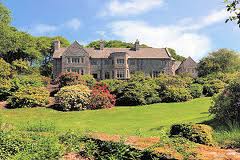
|
| Buncar House | The representatives of Rev. Denis Mahony were leasing this property to John O'Dowd at the time of Griffith's Valuation, when it was valued at £9 15s. Bary states that the Mahonys may orginally have built the house as a hunting lodge, perhaps at the beginning of the nineteenth century. It was enlarged several times afterwards and had several different owners. It is still extant though in need of renovation. | |
| Molahiffe House | Eliza Griffin was the lessor of this property at the time of Griffith's Valuation, when it was valued at almost £6 and vacant. In 1837 Lewis mentions "Boucheens" as the residence of Montague Griffin. Bary states that this is a very old house and is widely believed to be one of the earliest homes of the Browne family, later Lords Kenmare. It is still extant and occupied. |
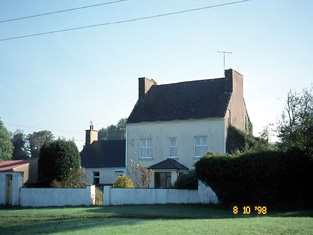
|
| Cloonlara | Christopher Gallway was leasing this property to William Hickson at the time of Griffith's Valuation, when it was valued at £7 5s. A farm is still extant at the site. | |
| Corbally House (Magunihy) | The Kenmare estate was the lessor of Corbally House at the time of Griffith's Valuation, when it was valued at £11 5s. Bary states that this farm was originally held by the O'Connor, probably of nearby Fieries Castle. Later a Fr. Dunne built Corbally House as a presbytery near the old Catholic Church. The property is still extant and occupied. | |
| Knocknaman | Henry Denny was leasing a property valued at £9 to William Thompson at the time of Griffith’s Valuation. An uunamed house, surrounded by trees, is marked on the 1st edition OS map. There is no house at this site now. | |
| Ballyhar House | In 1786 Wilson refers to Ballyhar, the residence of Mr. Eager. John Leahy was in possession of this property at the time of Griffith's Valuation when it was valued at £17. Bary states that this house was originally built by the Eager family but later sold to the Leahys. It is now a ruin. | |
| Mount St. Annagh | St. John Mason was leasing this property to Johanna O'Connor at the time of Griffith's Valuation, when the house, valued at £3 10s, stood on 800 acres. Johanna O'Connor was one of the principal lessors in the parish of Annagh at that time. The original house is no longer extant. | |
| Caherwisheen | Robert A. Thompson was in possession of this property at the time of Griffith's Valuation, when it was valued at £15. | |
| Ballyard House | At the time of Griffith's Valuation, Francis Crosbie was leasing Ballyard House from Reverend Arthur Rowan, when it was valued at £35. The Colthurst Estate sale notice of 1856 notes that Thompson leased the property from Nicholas Colthurst in the 1820s and that A.B. Rowan was an assignee of Thompson. Bary states that this house was possibly re-modelled by Peter Thompson in the late 1820s. |

|
| Ballyard | The representatives of Peter Foley were leasing a property at Ballyard to Margaret Crosbie at the time of Griffith's Valuation, when it was valued at £30. Lewis records Ballard as the seat of Francis Crosbie in 1837. | |
| Ballyard B | Geoffrey Eager was leasing a property to Patrick Ryan at the time of Griffith's Valuation, when it was valued at £15. | |
| West Villa or West Lodge | Edward Mulchinock was leasing this property from Sir George Colthurst at the time of Griffith's Valuation when it was valued at £15. Bary writes that this is the house associated with William Mulchinock, the writer of the famous song "The Rose of Tralee". It is still extant and occupied. | |
| Cloghane Lodge or Fortlands | At the time of Griffith's Valuation, it was being leased by Francis Fitzgerald to Andrew Shea and was valued at £15. It is still extant. Bary writes that this house was built by the Conway family, possibly in the seventeenth century. It was eventually sold by Nicholas Conway Colthurst to Peter Thompson in the 1820s. The 1856 sale notice records Francis Fitzgerald as the assignee of Peter Thompson. | |
| Cloghers House | In 1786 Wilson refers to Cloghers as the seat of Richard Yielding. John Mulchinock was leasing two adjoining properties from the Colthurst estate at the time of Griffith's Valuation, one valued at £50 and the second at £15. The Irish Tourist Association Survey notes that Cloghers was "once the home of the Mulchinock family who were big landowners" and relates the story of the song "the Rose of Tralee". Bary writes that this property was associated with the Carrigue family in the eighteenth century and also that John Mulchinock was an uncle of William Mulchinock, author of the song. She indicates that it was later owned by the Fitzmaurice family. It is still extant. |
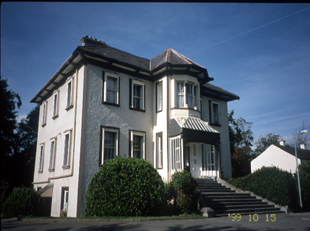
|
| Belmont | Reverend Arthur Rowan was leasing Belmont from Arthur Chute at the time of Griffith's Valuation, when it was valued at £40. Lewis records it as the seat of Reverend A.B. Rowan in 1837. The Ordnance Survey Name Books suggest the house was built by his father in 1826 and cost £1500. However, Bary states that the house, in common with other houses in the vicinity, was built by Peter Thompson in the 1820s, when he was Treasurer of County Kerry. It is still extant and occupied. |
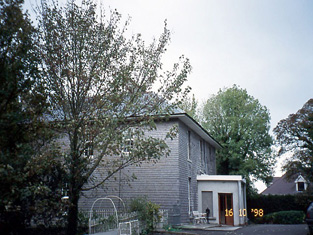
|
| Spring Lodge | Rev. Arthur Rowan was leasing this property to Robert Bell at the time of Griffith's Valuation, when it was valued at £15. Lewis records Spring Lodge as the residence of F.J. Martelli in 1837. Bary states that this is another of the houses built by Peter Thompson in the 1820s. Rowan was married to his daughter Alicia and they lived at nearby Belmont. Spring Lodge is still extant. | |
| Lohercannon House | Catherine Day was leasing this property to Richard Murphy at the time of Griffith's Valuation when it was valued at £15. In 1786 Wilson refers to "Lower-cannon" as "formerly the seat of Rev. Mr. Day, accidentally destroyed by fire". The Ordnance Survey Name Books describe it as the seat of Edward Orpen but originally built by the Day family. Lohercannan is referred to in the Irish Tourist Association Survey of the 1940s as "another building that would be worht a visit".The second house also seems to have been held by the Days but leased out to other families including the Morrises and Eagers. It was demolished to make way for housing in the 1960s. | |
| Lassinah | John Day Stokes was leasing this property from Sir Edward Denny at the time of Griffith's Valuation, when it was valued at £20 10s. Bary states that Major Stokes retired here from his Indian Army post and renovated the house where he lived until 1862. It remained in the Stokes family until the end of the nineteenth century and was recorded by Slater as the seat of Maj. Oliver R. Stokes in 1894. It is still extant but ruined. | |
| Kent Lodge | Richard O'Connell was leasing this property from the Denny estate at the time of Griffith's Valuation, when it was valued at £10 10s. Bary states that this house was attached to an earlier building known as O'Connell's Cottage where Rickard O'Connell lived but that Kent Lodge was built by William Collis. The house, which is still extant, remained in the Collis family until the early twentieth century. |
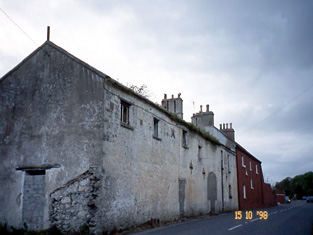
|
| Frogmore | John McCartie or McCarthy was leasing this property from Sir Edward Denny at the time of Griffith's Valuation, when it was valued at £16. Lewis records Frogmore Lodge as the seat of Reverend Barry Denny in 1837.The Ordnance Survey Name Books reported that it was built by him in 1828 at a cost of £600 and was lived in, in 1840, by Mrs. Townsend Gunn. It is still extant. | |
| Curragh | William John Neligan was leasing this property from the Denny estate at the time of Griffith's Valuation, when it was valued at £8 10s. Bary indicates that the house has always been occupied by merchant families from Tralee. It is still extant. | |
| Abbeylands or The Abbey | Abraham Huggard was leasing this property from Sir William Godfrey at the time of Griffith's Valuation when it was valued at £5 10s. Local sources suggest it was built by the Huggard family in the early nineteenth century. It is still extant and occupied. | |
| Kilburn House | Edward Godfrey was leasing Kilburn House to John W. Bonner at the time of Griffith's Valuation, when it was valued at £11 5s. Bary states that this property was owned for much of the nineteenth century by Reverend William Godfrey and his wife, Lucy Day but was usually let to a tenant. The property is still extant and now a farmhouse B&B run by the Leane family. See www.stayatkilburn.com |
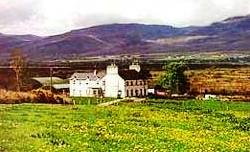
|
| Kilcolman Abbey | Kilcoleman Abbey was the residence of Sir William Godfrey at the time of Griffith's Valuation, when it was valued at £33. Lewis also records it as his residence in 1837. In 1894 Slater referred to it as the seat of Sir John F. Godfrey. In 1906, it was still part of the Godfrey estate and valued at £35 10s.The Irish Tourist Association survey of the early 1940s refers to it as "Godfrey House, a fine type of Elizabethan type mansion". Bary states that the original house, built by the first Godfrey to settle in the area at the end of the seventeenth century, was called Bushfield but that it burned down in 1774 though Wilson still refers to it by this name in 1786 and provides a detailed description of the surroundings. Knightly indicates that a new house was then built by Sir William Godfrey. This house was remodelled twice in the nineteenth century. Sir William Maurice Godfrey sold Kilcoleman in the 1960s and it was demolished in 1977. |
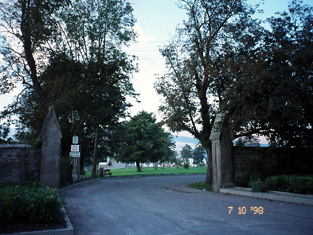
|
| Rathpoge | At the time of Griffith's Valuation, Sir William Godfrey was leasing this property to William Hickson. No house is marked in this area on the Ordnance Survey map, the only buildings being the Kilcolman farmyard. The buildings on the site were valued at £13. It was still in the possession of the Godfrey estate in 1906 with the same valuation but are no longer extant. | |
| Callanafersy House A | Robert Leeson was leasing Callanafersy House to Ephraim Williams at the time of Griffith's Valuation, when it was valued at £12 5s. Bary indicates that this house was leased by the Williams family and probably had been built by them earlier in the nineteenth century. It is still extant and occupied. | |
| Callanafersy House | Richard J. Leeson-Marshall built Callanafersy House around 1861 and the family continued to own the house until well into the twentieth century. It is still extant and occupied. |
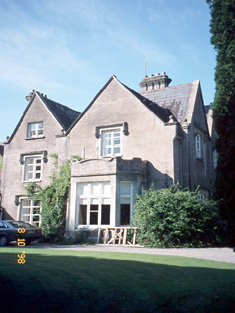
|
| Glen Ellen (Kilcolman) | James Godfrey was leasing this property from Lord Monteagle's estate at the time of Griffith's Valuation, when it was valued at £11 10s. Bary indicates that it was in the possession of a branch of the Godfrey family up until the end of the nineteenth century when it was then sold to the Huggard family. Slater notes it as the residence of Jn. T. Huggard in 1894. It has had several owners since then but is still extant and occupied. | |
| Keel House | Edward Rae was in possession of Keel House at the time of Griffith's Valuation. Lewis records it as the seat of Giles Rae in 1837. Bary states this was originally a Langford House, possibly built as far back as the 1680s but with later modificiations. Wilson refers to it as the seat of Mr. Langford in 1786. It passed by marriage to the Rae family with whom it remained until the twentieth century. It was sold but later re-purchased by the family and is still extant. |

|
| Altavilla | Robert Rae was the owner of this property at the time of Griffith's Valuation, when it was valued at £5 5s. It is named as Altavilla on the 1st edition Ordnance Survey map. In 1837 Lewis refers to Ardmoniel Cottage, the seat of R. Rae, but also to Altavilla, residence of J. Morrogh. Bary mentions that Altavilla was associated with the Morrogh family. It was later the residence of the Dodd family and is still extant. | |
| Reeks View | Rev. William de Moleyns was leasing this property from Lord Ventry's estate at the time of Griffith's Valuation, when it was valued at £4 15s, on a holding of 140 acres. It appears on the 1893 edition of the Ordnance Survey map as Reeks View. It is still extant. | |
| Anna | Sir William Godfrey was leasing this property to Cornelius Murphy at the time of Griffith's Valuation when it was valued at £10 5s. Lewis records it as the residence of Reverend O'Connor, PP, in 1837. In 1814 Leet mentions Annagh as the seat of Giles Rae. Bary writes that it was built by the Godfreys in the eighteenth century and was lived in by various members of that family until the early nineteenth century when it was occupied by tenants. It was tragically burnt to the ground in the late twentieth century. Sir William was leasing a second property in this townland to Willam R. Burke, valued at £8 10s. | |
| Laharan House | Sir William Godfrey was leasing this property to James O'Neill at the time of Griffith's Valuation, when it was valued at £7 5s, and part of a holding of 170 acres. It was recorded as the seat of F. Walker by Lewis in 1837 and Leet in 1814 as the seat of Francis Walker. Bary states that it was built by Francis Walker in 1808. The house passed to the Cronin family in the 1880s. It is stil extant and occupied. | |
| Cloonalassan House | Lord Monteagle was leasing this property to John Giles at the time of Griffith's Valuation, when it was valued at £8 5s, on a demesne of 123 acres, some of which extended into Ballycrispin townland. Lewis mentions, in 1837, that Ballycrispin was formerly the residence of the Spring-Rice ancestors. It is not shown on the later 25-inch Ordnance Survey map of the 1890s. | |
| Meanus House (Kiltallagh) | Lady Anne Headley's estate was leasing this property to Charlotte Walker at the time of Griffith's Valuation, when it was valued at £9 15s. Bary writes that it was leased by the Winn estate in the early part of the nineteenth century to the Walkers and later to the Spring family. It is still extant and was renovated in the twentieth century. |
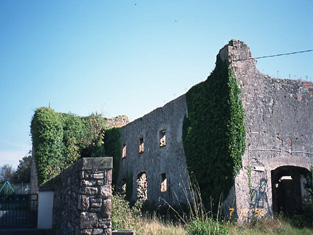
|
| Kiltallagh Glebe | Rev. Brownrigg (or possibly Browning) Drew was in possession of Kiltallagh Glebe at the time of Griffith's Valuation, when it was valued at £17. Lewis records it as the seat of Rev.J. Murphy in 1837. In 1786 Wilson refers to "Menus"as the house of Dr. Drew but he also refers to a residence of Rev. Dr. Day, near Kiltalla church. Bary mentions that it was renovated by Rev. Murphy earlier in the nineteenth century. It was also associated with the Day and Godfrey families. In 1920 it was sold to the Boyle family by the Representative Church Body and is still extant and occupied. | |
| Rockfield | In 1837 Lewis noted that "Rockville" was the property of the representatives of the late John Drew. At the time of Griffith's Valuation, William Whorland was leasing a property valued at £5 10s from the Drew estate. The property was offered for sale by Alicia Wherland in the Landed Estates Court in July 1862 and again in July 1872. In 1906 Rockfield was owned by Bertram Morrogh Bernard and was valued at £11. Bary mentions it as a house associated with the Sealy family. Buildings are still extant at the site. | |
| Oyster Hall | Edward Denny was leasing this property to William J. Neligan at the time of Griffith's Valuation, when it was valued at £18 Lewis refers to it as the seat of Barry Collins while Oyster Lodge was the residence of Mr.Neligan in 1837. IIn the 1830s, the Ordnance Survey Field Name Books mention Oyster Hall as the seat of Daniel Supple but originally built by George Rowan in 1804. In 1814, Leet refers to Oyster Hall as the residence of George Rowan. Bary states that Oyster Hall was orginally built by the Rowans but was associated with the Neligans by the middle of the nineteenth century. It is no longer extant. | |
| Fahagh Court | In 1786 Wilson mentions Fagha as the seat of Mr. Falvey. At the time of Griffith's Valuation, Daniel Buckley was leasing this property from John Morrogh Bernard, when it was valued at £3 10s. In 1906 Bertram Morrogh Bernard owned this property, then valued at £25. A house built n the later nineteenth century, it is labelled Fahagh Court on the 25-inch Ordnance Survey map of the 1890s. In 1943 the Irish Tourist Association survey noted that it had been extensively reconstructed and modernised and "bears little resemblance to the historic residence of the Morrogh-Bernards and before them the O'Flavey clan". It was then occupied by the Reynolds family. Bary states that the property became a hotel in the twentieth century before being damaged by fire. The extensive yard complex has now become the Killarney Country Club and holiday accommodation. |

|
| Glenfield House | In 1906 Major P. Chute owned a property at Ballygarret, barony of Corkaguiny, valued at £35 10s. At the time of Griffith's Valuation, this townland was in the possession of Nathaniel Bland. The house does not appear on the First Edition Ordnance Survery map but is labelled Glenfield House on the later 25-inch edition of the 1890s. In 1894 Slater noted it as the seat of Captain Thomas Chute. The original house is no longer extant. | |
| Tralee | At the time of Griffith's Valuation, Francis Crumpe was leasing a property, valued at £31, at Denny St., Tralee, from John Donovan. [Grid Reference is approximate]. | |
| Tralee Castle | In 1786 Wilson writes "at Tralee is a castle in tolerable preservation, formerly one of the castles of the Earls of Desmond, granted by Queen Elizabeth to Sir Anthony Denny, and now the seat of his descendent, Sir Barry Denny". In 1943 the Irish Tourist Association Survey mentions that the last reconstruction of the building occurred in 1802. Bary writes that, after the Act of Union, the Denny family spent more time in England and the castle fell out of use and was eventually demolished and the stones used for other buildings. | |
| Roxborough (Molahiffe) | Wilson, writing in 1786, refers to Roxborough as the seat of Francis Chute. At the time of Griffith's Valuation, the townland was part of the estate of Reverend George Chute and Roxborough House was occupied by a Mrs Kenny and valued at almost £7. It is still extant and used as a farmhouse. | |
| Molahiffe Castle | At the time of Griffith's Valuation, Maurice de Coursey was leasing a property in the townland of Castlefarm from the Kenmare estate which had a valuation of almost £6. It is likely to have been the house labelled on both the 1st and later 25-inch edition Ordnance Survey Maps as Molahiffe Castle. The National Inventory of Architectural Heritage states that this house was built in the mid-eighteenth century. In 1943 the Irish Tourist Association Survey highlights the close links between Molahiffe and the Browne family, who, it says, resided in the area until the building of the first Killarney House. The remains of the original Molahiffe castle are located a short distance from the present house, now known as Castlefarm House. |
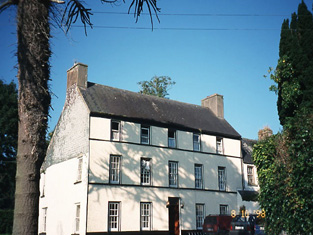
|

